Immunizations have come a long way since the first vaccine was discovered for smallpox by Edward Jenner in 1796. It took a little more than 100 years to pass before Dr. Louis Pasteur was able to prove that disease could be prevented by infecting humans with weakened germs when he used a vaccine to successfully prevent rabies in a boy bitten by a rabid dog. By the mid-20th century, Dr Jonas Salk and Dr. Albert Sabin developed the inactivated polio vaccine and live polio vaccine, respectively. With that and subsequent ones developed, vaccines have prevented the spread of serious childhood infectious diseases, which has saved countless lives and has prevented children from having to live with long-term health issues such as blindness, deafness, loss of limbs, or paralysis that may occur with some of these childhood infections.
Pediatric immunizations are vital to the health of a child. Following is a chart that lists the common pediatric immunizations recommended by the Centers for Disease Control and Prevention. The chart is formatted in chronological order from birth to 18 years of age and lists the recommended immunization for each age group. It also lists what the immunization protects against and the possible sequelae if the child is not immunized. Last, the chart also provides nursing considerations that include how the bacteria or virus is spread, which is helpful when teaching parents and caregivers preventative measures to keep children healthy, and important information that pertains only to a specific immunization. Monitor all pediatric patients for common reactions that may occur after the immunization has been given. These reactions are usually mild and resolve quickly such as local reactions at the injection site (burning, itching, pain, redness, or swelling) or a mild fever.
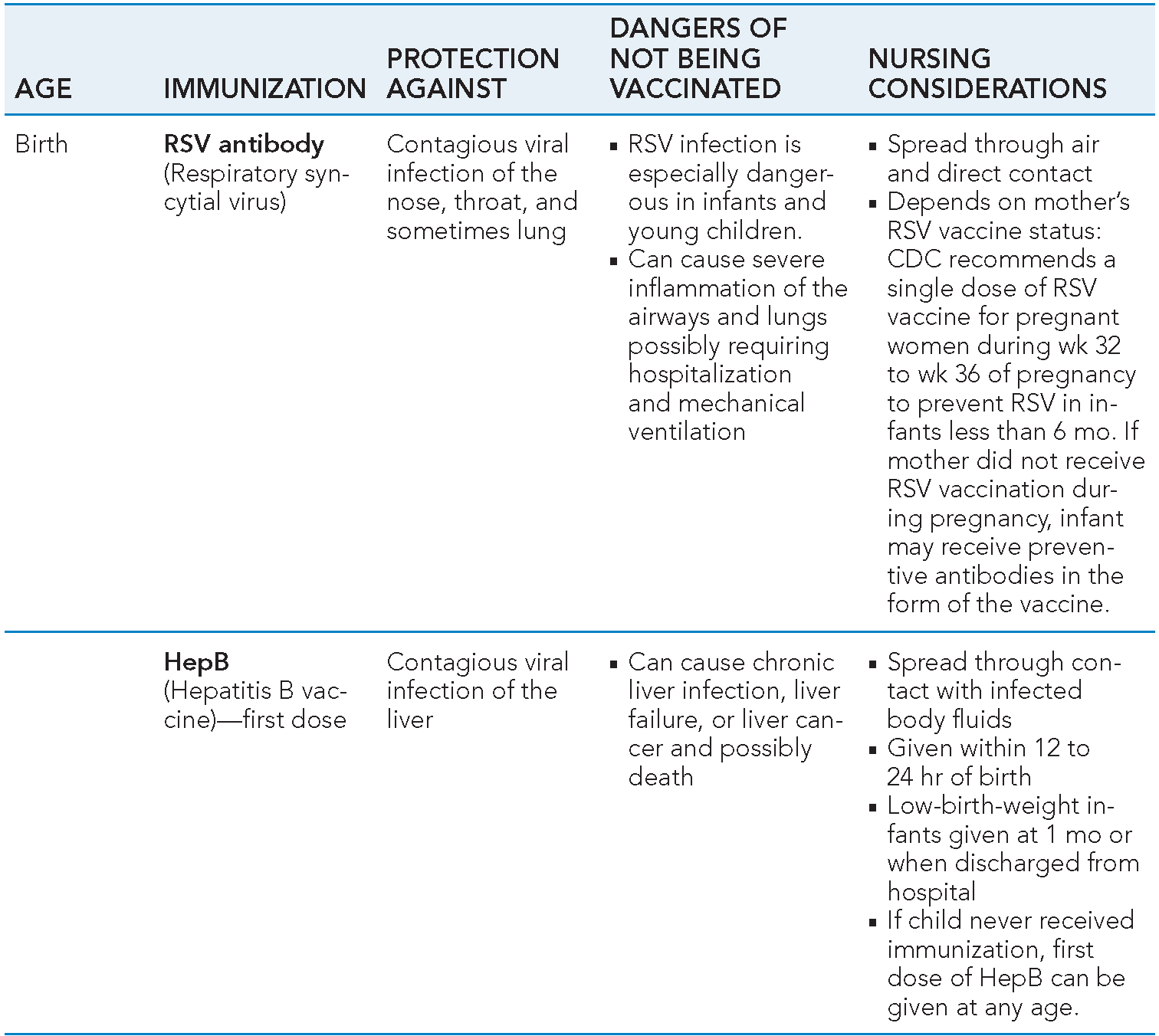
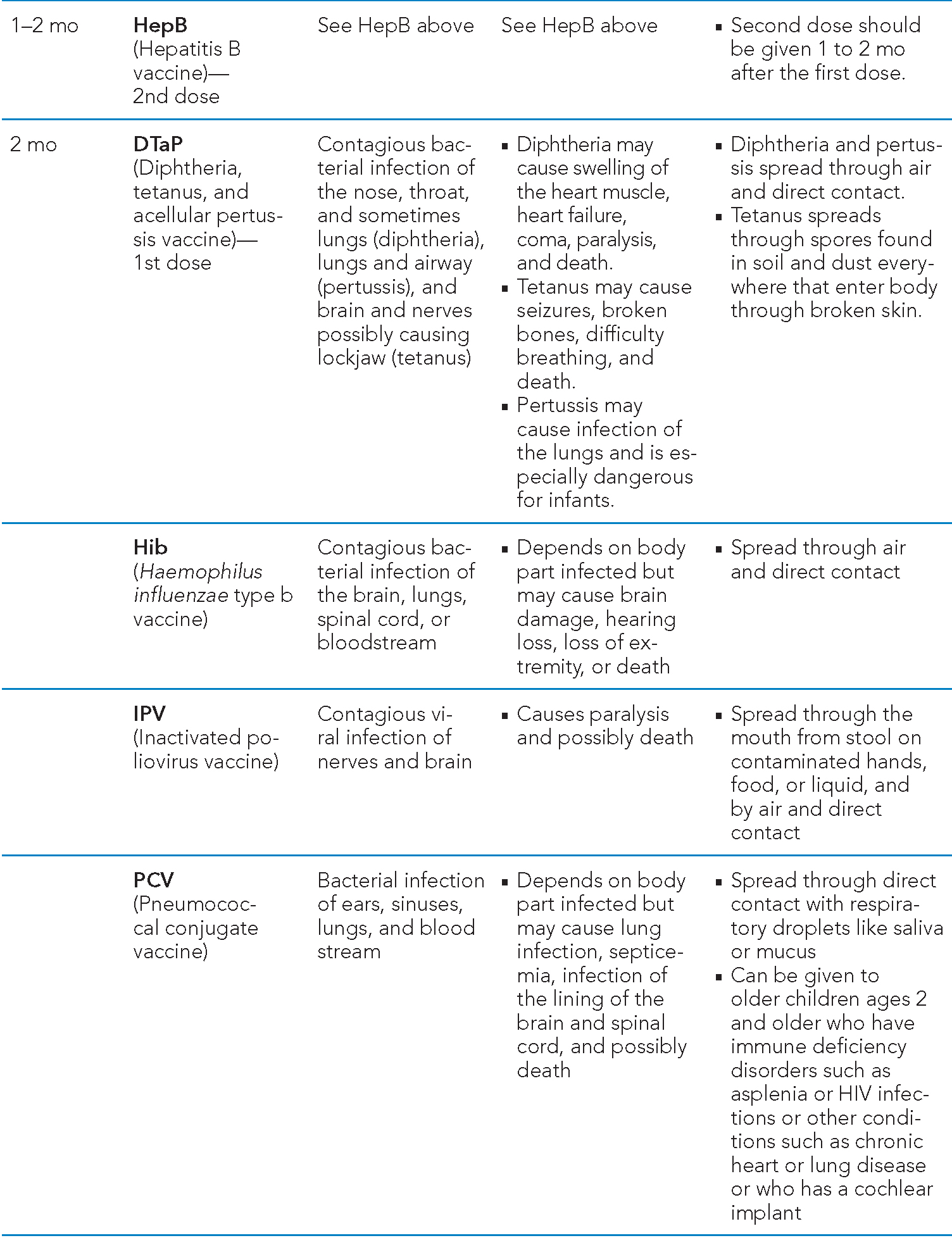
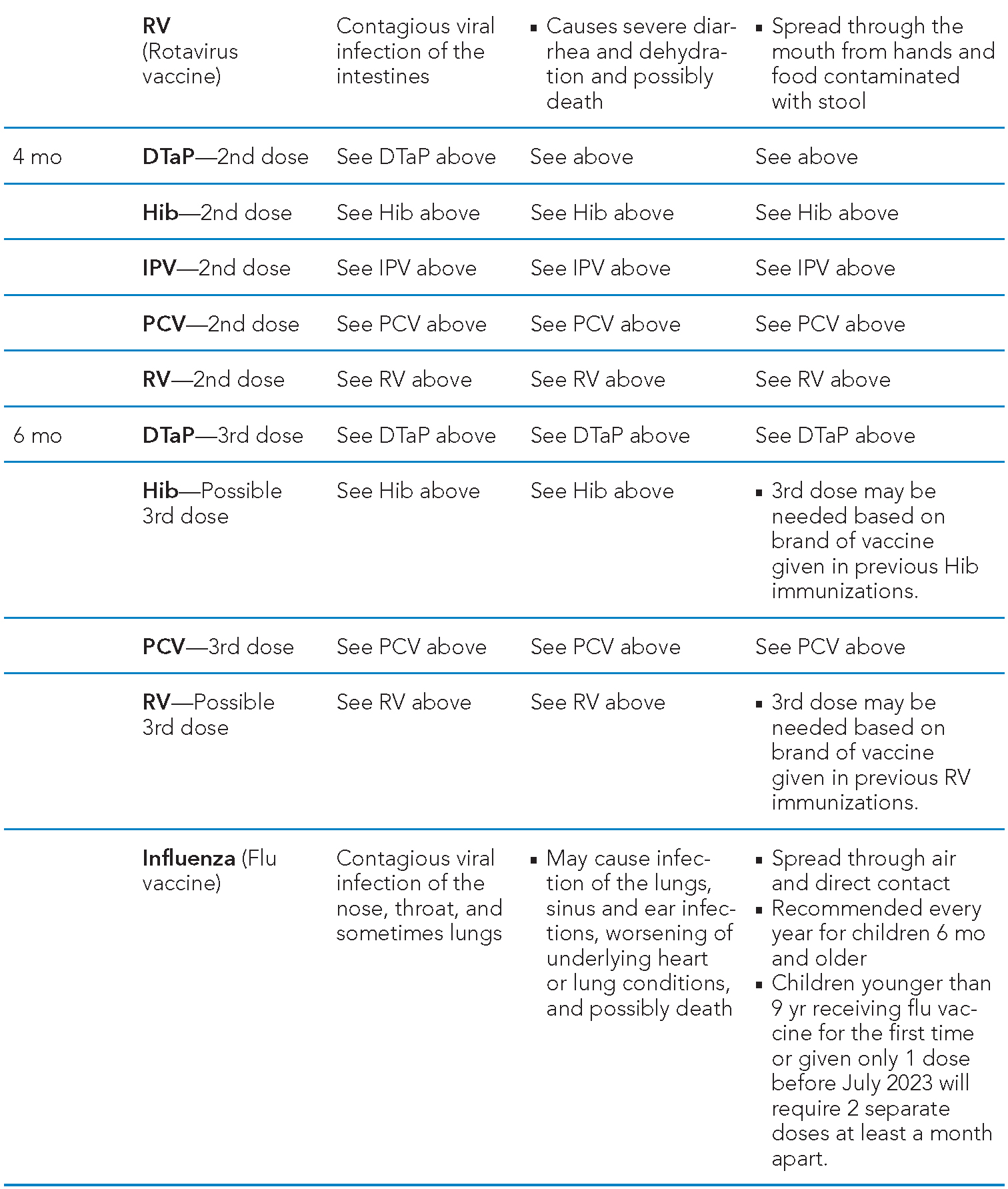
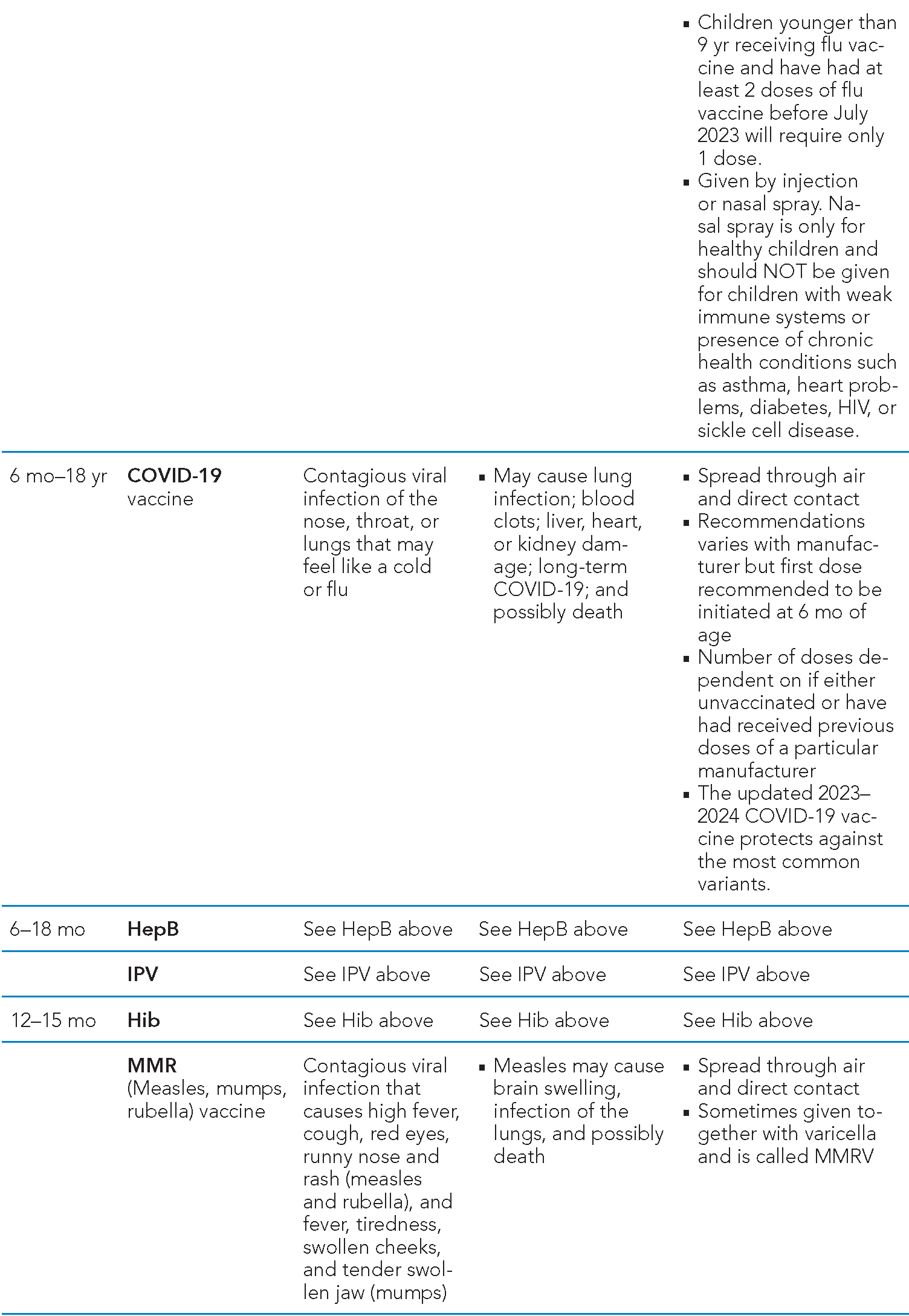
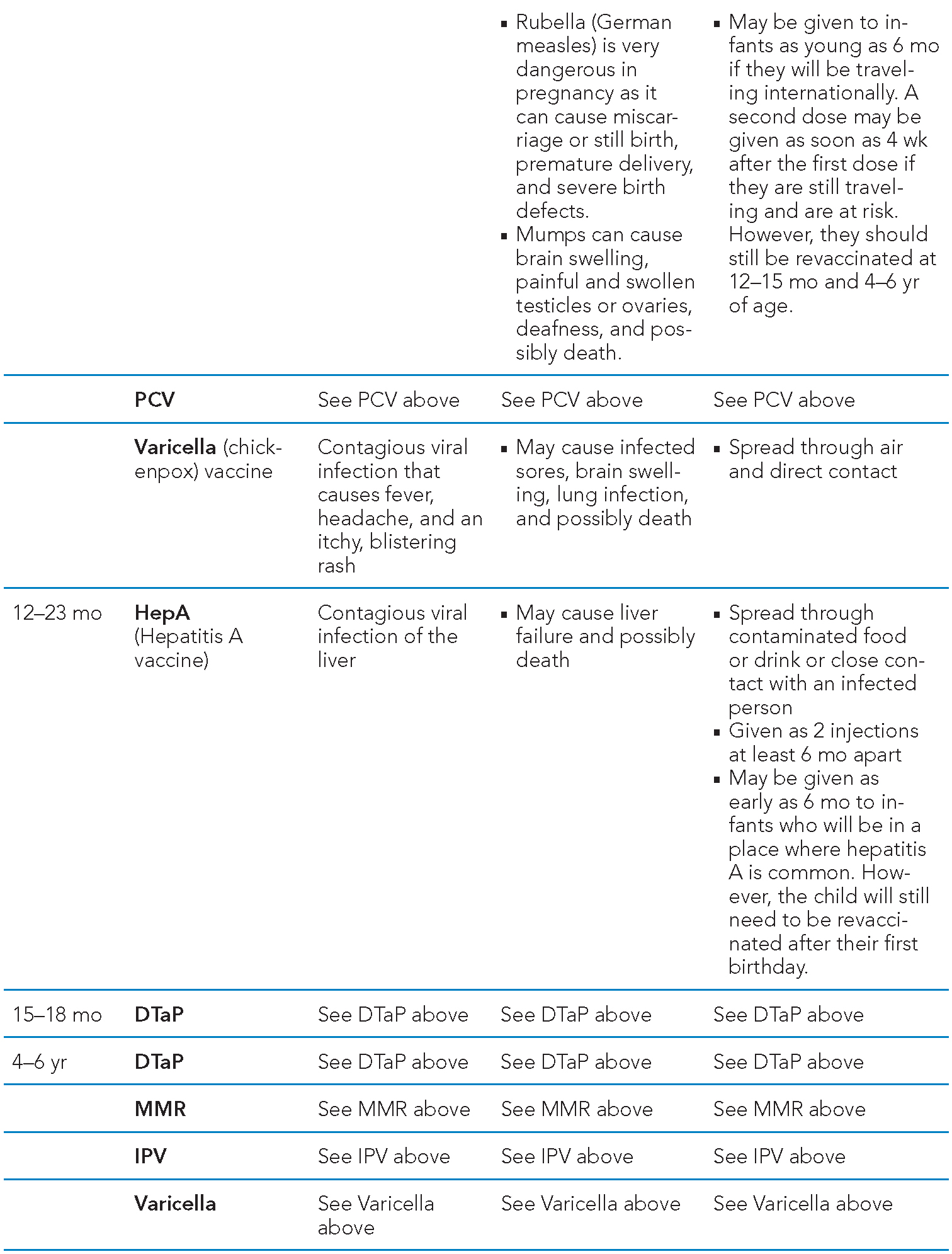
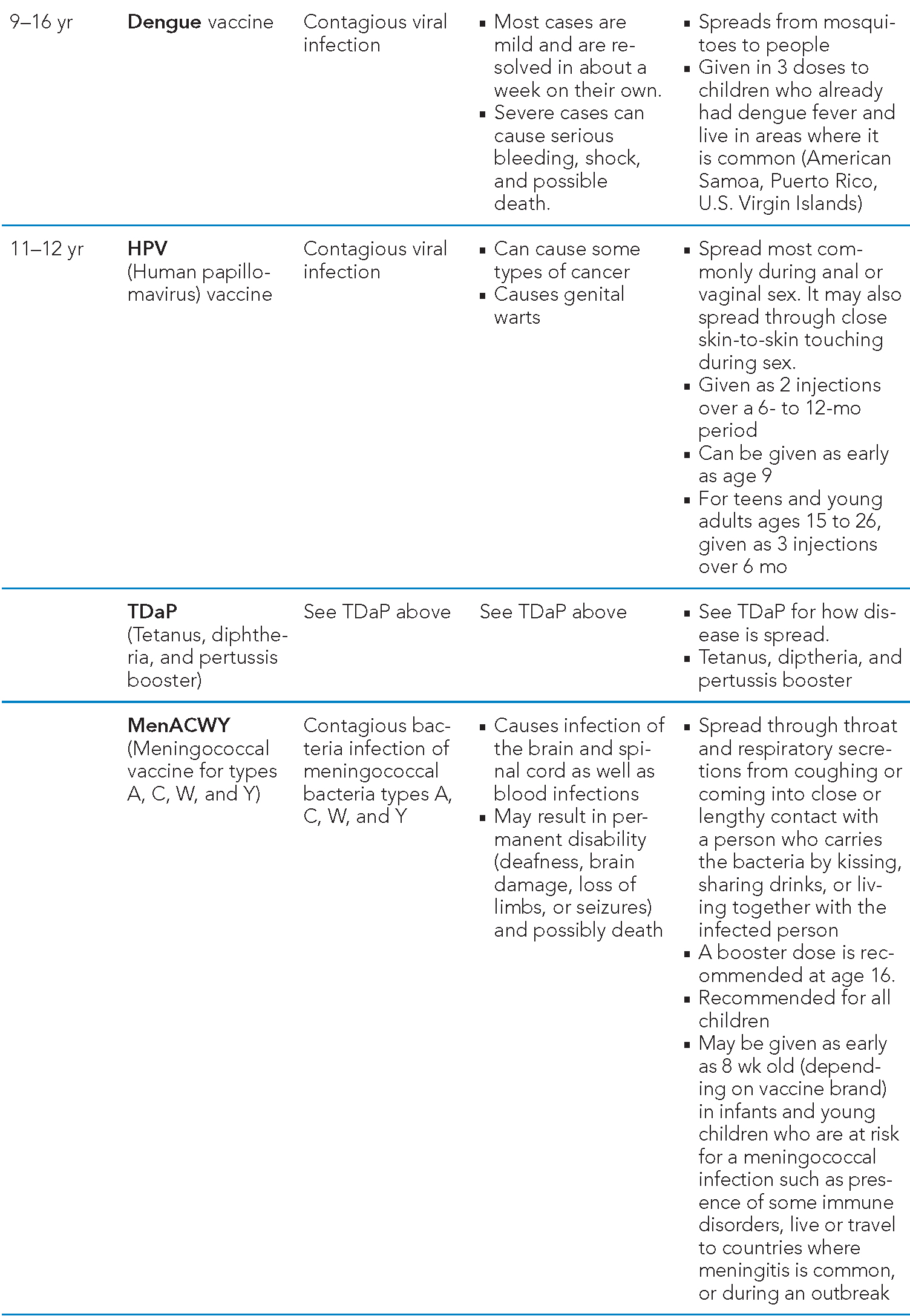
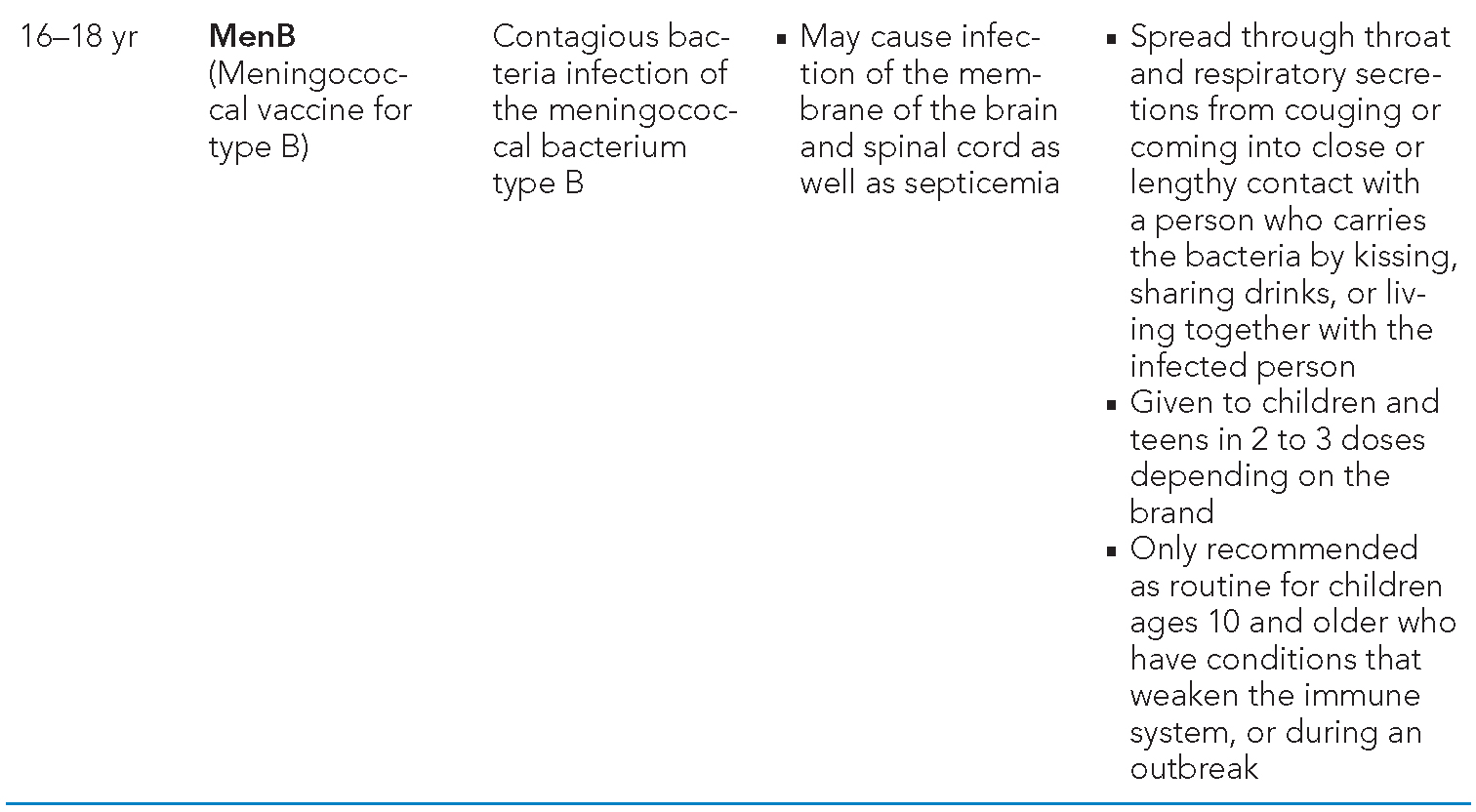
A table is titled Pediatric Immunizations
Text above the table reads, Immunizations have come a long way since the first vaccine was discovered for smallpox by Edward Jenner in 1796. It took a little more than 100 years to pass before Doctor Louis Pasteur was able to prove that disease could be prevented by infecting humans with weakened germs when he used a vaccine to successfully prevent rabies in a boy bitten by a rabid dog. By the mid-20th century, Doctor Jonas Salk and Doctor Albert Sabin developed the inactivated polio vaccine and live polio vaccine, respectively. With that and subsequent ones developed, vaccines have prevented the spread of serious childhood infectious diseases, which has saved countless lives and has prevented children from having to live with long-term health issues such as blindness, deafness, loss of limbs, or paralysis that may occur with some of these childhood infections. Pediatric immunizations are vital to the health of a child. Following is a chart that lists the common pediatric immunizations recommended by the Centers for Disease Control and Prevention. The chart is formatted in chronological order from birth to 18 years of age and lists the recommended immunization for each age group. It also lists what the immunization protects against and the possible sequelae if the child is not immunized. Last, the chart also provides nursing considerations that include how the bacteria or virus is spread, which is helpful when teaching parents and caregivers preventative measures to keep children healthy, and important information that pertains only to a specific immunization. Monitor all pediatric patients for common reactions that may occur after the immunization has been given. These reactions are usually mild and resolve quickly such as local reactions at the injection site, burning, itching, pain, redness, or swelling, or a mild fever. The table consists of five columns: Age, immunization, protection against, dangers of not being vaccinated, and nursing considerations. Row entries are as follows. Row 1. Age: Birth. Immunization: R S V antibody, Respiratory syncytial virus. Protection against: Contagious viral infection of the nose, throat, and sometimes lung. Dangers of not being vaccinated: R S V infection is especially dangerous in infants and young children. Can cause severe inflammation of the airways and lungs possibly requiring hospitalization and mechanical ventilation. Nursing considerations: Spread through air and direct contact. Depends on mother’s R S V vaccine status: C D C recommends a single dose of R S V vaccine for pregnant people during week 32 to week 36 of pregnancy to prevent R SV in infants less than 6 months. If mother did not receive R S V vaccination during pregnancy, infant may receive preventive antibodies in the form of the vaccine. Row 2. Age: Birth. Immunization: Hep B, Hepatitis B vaccine, first dose. Protection against: Contagious viral infection of the liver. Dangers of not being vaccinated: Can cause chronic liver infection, liver failure, or liver cancer and possibly death. Nursing considerations: Spread through contact with infected body fluids. Given within 12 to 24 hours of birth. Low-birth-weight infants given at 1 month or when discharged from hospital. If child never received immunization, first dose of Hep B can be given at any age. The table consists of five columns: Age, immunization, protection against, dangers of not being vaccinated, and nursing considerations. Row entries are as follows. Row 3. Age: 1 to 2 months. Immunization: Hep B, Hepatitis B vaccine, 2nd dose. Protection against: See Hep B above. Dangers of not being vaccinated: See Hep B above. Nursing considerations: Second dose should be given 1 to 2 months after the first dose. Row 4. Age: 2 Months. Immunization: D TaP, Diphtheria, tetanus, and acellular pertussis vaccine, 1st dose. Protection against: Contagious bacterial infection of the nose; throat; and sometimes lungs, diphtheria; lungs and airway, pertussis; and brain and nerves possibly causing lockjaw, tetanus. Dangers of not being vaccinated: Diphtheria may cause swelling of the heart muscle, heart failure, coma, paralysis, and death. Tetanus may cause seizures, broken bones, difficulty breathing, and death. Pertussis may cause infection of the lungs and is especially dangerous for infants. Nursing considerations: Diphtheria and pertussis spread through air and direct contact. Tetanus spreads through spores found in soil and dust everywhere that enter body through broken skin. Row 5. Age: 2 Months. Immunization: Hib, Haemophilus influenzae type b vaccine. Protection against: Contagious bacterial infection of the brain, lungs, spinal cord, or bloodstream. Dangers of not being vaccinated: Depends on body part infected but may cause brain damage, hearing loss, loss of extremity, or death. Nursing considerations: Spread through air and direct contact. Row 6. Age: 2 Months. Immunization: I P V, Inactivated poliovirus vaccine. Protection against: Contagious viral infection of nerves and brain. Dangers of not being vaccinated: Causes paralysis and possibly death. Nursing considerations: Spread through the mouth from stool on contaminated hands, food, or liquid, and by air and direct contact. Row 7. Age: 2 Months. Immunization: P C V, Pneumococcal conjugate vaccine. Protection against: Bacterial infection of ears, sinuses, lungs, and blood stream. Dangers of not being vaccinated: Depends on body part infected but may cause lung infection, septicemia, infection of the lining of the brain and spinal cord, and possibly death. Nursing considerations: Spread through direct contact with respiratory droplets like saliva or mucus. Can be given to older children ages 2 and older who have immune deficiency disorders such as asplenia or H I V infections or other conditions such as chronic heart or lung disease or who has a cochlear implant. Row 8. Age: 2 Months. Immunization: R V, Rotavirus vaccine. Protection against: Contagious viral infection of the intestines. Dangers of not being vaccinated: Causes severe diarrhea and dehydration and possibly death. Nursing considerations: Spread through the mouth from hands and food contaminated with stool. Row 9. Age: 4 months. Immunization: D TaP, 2nd dose. Protection against: See D TaP above. Dangers of not being vaccinated: See above. Nursing considerations: See above. Row 10. Age: 4 months. Immunization: Hib, 2nd dose. Protection against: See Hib above. Dangers of not being vaccinated: See Hib above. Nursing considerations: See Hib above. The table consists of five columns: Age, immunization, protection against, dangers of not being vaccinated, and nursing considerations. Row entries are as follows. Row 11. Age: 4 months. Immunization: I P V, 2nd dose. Protection against: See I P V above. Dangers of not being vaccinated: See I P V above. Nursing considerations: See I P V above. Row 12. Age: 4 months. Immunization: P C V, 2nd dose. Protection against: See P C V above. Dangers of not being vaccinated: See P C V above. Nursing considerations: See P C V above. Row 13. Age: 4 months. Immunization: R V, 2nd dose. Protection against: See R V above. Dangers of not being vaccinated: See R V above. Nursing considerations: See R V above. Row 14. Age: 6 months. Immunization: D TaP, 3rd dose. Protection against: See D TaP above. Dangers of not being vaccinated: See D TaP above. Nursing considerations: See D TaP above. Row 15. Age: 6 months. Immunization: Hib, Possible 3rd dose. Protection against: See Hib above. Dangers of not being vaccinated: See Hib above. Nursing considerations: 3rd dose may be needed based on brand of vaccine given in previous Hib immunizations. Row 16. Age: 6 months. Immunization: P C V, 3rd dose. Protection against: See P C V above. Dangers of not being vaccinated: See P C V above. Nursing considerations: See P C V above. Row 17. Age: 6 months. Immunization: R V, Possible 3rd dose. Protection against: See R V above. Dangers of not being vaccinated: See R V above. Nursing considerations: 3rd dose may be needed based on brand of vaccine given in previous R V immunizations. Row 18. Age: 6 months. Immunization: Influenza, Flu vaccine. Protection against: Contagious viral infection of the nose, throat, and sometimes lungs. Dangers of not being vaccinated: May cause infection of the lungs, sinus and ear infections, worsening of underlying heart or lung conditions, and possibly death. Nursing considerations: Spread through air and direct contact. Recommended every year for children 6 months and older. Children younger than 9 years receiving flu vaccine for the first time or given only 1 dose before July 2023 will require 2 separate doses at least a month apart. Children younger than 9 years receiving flu vaccine and have had at least 2 doses of flu vaccine before July 2023 will require only 1 dose. Given by injection or nasal spray. Nasal spray is only for healthy children and should NOT be given for children with weak immune systems or presence of chronic health conditions such as asthma, heart problems, diabetes, H I V, or sickle cell disease. The table consists of five columns: Age, immunization, protection against, dangers of not being vaccinated, and nursing considerations. Row entries are as follows. Row 19. Age: 6 months to 18 years. Immunization: COVID-19 vaccine. Protection against: Contagious viral infection of the nose, throat, or lungs that may feel like a cold or flu. Dangers of not being vaccinated: May cause lung infection; blood clots; liver, heart, or kidney damage; long-term COVID-19; and possibly death. Nursing considerations: Spread through air and direct contact. Recommendations varies with manufacturer but first dose recommended to be initiated at 6 months of age. Number of doses dependent on if either unvaccinated or have had received previous doses of a particular manufacturer. The updated 2023 to 2024 COVID-19 vaccine protects against the most common variants. Row 20. Age: 6 to 18 months. Immunization: Hep B. Protection against: See Hep B above. Dangers of not being vaccinated: See Hep B above. Nursing considerations: See Hep B above. Row 21. Age: 6 to 18 months. Immunization: I P V. Protection against: See I P V above. Dangers of not being vaccinated: See I P V above. Nursing considerations: See I P V above. Row 22. Age: 12 to 15 months. Immunization: Hib. Protection against: See Hip above. Dangers of not being vaccinated: See Hib above. Nursing considerations: See Hib above. Row 23. Age: 12 to 15 months. Immunization: M M R, Measles, mumps, rubella, vaccine. Protection against: Contagious viral infection that causes high fever, cough, red eyes, runny nose and rash, measles and rubella, and fever, tiredness, swollen cheeks, and tender swollen jaw, mumps. Dangers of not being vaccinated: Measles may cause brain swelling, infection of the lungs, and possibly death. Rubella, German measles, is very dangerous in pregnancy as it can cause miscarriage or still birth, premature delivery, and severe birth defects. Mumps can cause brain swelling, painful and swollen testicles or ovaries, deafness, and possibly death. Nursing considerations: Spread through air and direct contact. Sometimes given together with the varicella and is called M M R V. May be given to infants as young as 6 months if they will be traveling internationally. A second dose may be given as soon as 4 weeks after the first dose if they are still traveling and are at risk. However, they should still be revaccinated at 12 to 15 months and 4 to 6 years of age. Row 24. Age: 12 to 15 months. Immunization: P C V. Protection against: See P C V above. Dangers of not being vaccinated: See P C V above. Nursing considerations: See P C V above. Row 25. Age: 12 to 15 months. Immunization: Varicella, chickenpox, vaccine. Protection against: Contagious viral infection that causes fever, headache, and an itchy, blistering rash. Dangers of not being vaccinated: May cause infected sores, brain swelling, lung infection, and possibly death. Nursing considerations: Spread through air and direct contact. The table consists of five columns: Age, immunization, protection against, dangers of not being vaccinated, and nursing considerations. Row entries are as follows. Row 26. Age: 12 to 23 months. Immunization: Hep A, Hepatitis A vaccine. Protection against: Contagious viral infection of the liver. Dangers of not being vaccinated: May cause liver failure and possibly death. Nursing considerations: Spread through contaminated food or drink or close contact with an infected person. Given as 2 injections at least 6 months apart. May be given as early as 6 months to infants who will be in a place where hepatitis A is common. However, the child will still need to be revaccinated after their first birthday. Row 27. Age: 15 to 18 months. Immunization: D Tap. Protection against: See D TaP above. Dangers of not being vaccinated: See D TaP above. Nursing considerations: See D TaP above. Row 28. Age: 4 to 6 years. Immunization: M M R. Protection against: See M M R above. Dangers of not being vaccinated: See M M R above. Nursing considerations: See M M R above. Row 29. Age: 4 to 6 years. Immunization: I P V. Protection against: See I P V above. Dangers of not being vaccinated: See I P V above. Nursing considerations: See I P V above. Row 30. Age: 4 to 6 years. Immunization: Varicella. Protection against: See Varicella above. Dangers of not being vaccinated: See Varicella above. Nursing considerations: See Varicella above. Row 31. Age: 9 to 16 years. Immunization: Dengue vaccine. Protection against: Contagious viral infection. Dangers of not being vaccinated: Most cases are mild and are resolved in about a week on their own. Severe cases can cause serious bleeding, shock, and possible death. Nursing considerations: Spreads from mosquitoes to people. Given in 3 doses to children who already had dengue fever and live in areas where it is common, American Samoa, Puerto Rico, U.S. Virgin Islands. Row 32. Age: 11 to 12 years. Immunization: H P V, Human papillomavirus, vaccine. Protection against: Contagious viral infection. Dangers of not being vaccinated: Can cause some types of cancer. Causes genital warts. Nursing considerations: Spread most commonly during anal or vaginal sex. It may also spread through close skin-to-skin touching during sex. Given as 2 injections over a 6-to-12-month period. Can be given as early as age 9. For teens and young adults ages 15 to 26, given as 3 injections over 6 months. Row 33. Age: 9 to 12 years. Immunization: T DaP, Tetanus, diphtheria, and pertussis booster. Protection against: See T DaP above. Dangers of not being vaccinated: See T DaP above. Nursing considerations: See T DaP for how disease is spread. Tetanus, diptheria, and pertussis booster. The table consists of five columns: Age, immunization, protection against, dangers of not being vaccinated, and nursing considerations. Row entries are as follows. Row 34. Age: 11 to 12 years. Immunization: Men A C W Y, Meningococcal vaccine for types A, C, W, and Y. Protection against: Contagious bacteria infection of meningococcal bacteria types A, C, W, and Y. Dangers of not being vaccinated: Causes infection of the brain and spinal cord as well as blood infections. May insult in permanent disability, deafness, brain damage, loss of limbs, or seizures, and possibly death. Nursing considerations: Spread through throat and respiratory secretions from coughing or coming into close or lengthy contact with a person who carries the bacteria by kissing, sharing drinks, or living together with the infected person. A booster dose is recommended at age 16. Recommended for all children. May be given as early as 8 weeks old, depending on vaccine brand, in infants and young children who are at risk for a meningococcal infection such as presence of some immune disorders, live or travel to countries where meningitis is common, or during an outbreak. Row 35. Age: 16 to 18 years. Immunization: Men B, Meningococcal vaccine for type B. Protection against: Contagious bacteria infection of the meningococcal bacterium type B. Dangers of not being vaccinated: May cause infection of the membrane of the brain and spinal cord as well as septicemia. Nursing considerations: Spread through throat and respiratory secretions from couging or coming into close or lengthy contact with a person who carries the bacteria by kissing, sharing drinks, or living together with the infected person. Given to children and teens in 2 to 3 doses depending on the brand. Only recommended as routine for children ages 10 and older who have conditions that weaken the immune system, or during an outbreak. Source line reads, Data from Centers for Disease Control and Prevention. 2024. Child and adolescent immunization schedule by age, United States, 2024. Retrieved from h t t p s colon double forward slash w w w dot c d c dot gov forward slash vaccines forward slash schedules forward slash h c p forward slash i m z forward slash child hyphen adolescent dot h t m l. Data from Centers for Disease Control and Prevention. 2024. What diseases do these vaccines protect against? Retrieved from h t t p s colon double forward slash w w w dot c d c dot gov forward slash vaccines forward slash schedules forward slash easy hyphen to hyphen read forward slash child hyphen easyread dot h t m l. Data from Centers for Disease Control and Prevention. 2024. What disease do these vaccines protect against? Retrieved from h t t p s colon double forward slash w w w dot c d c dot gov forward slash vaccines forward slash schedules forward slash easy hyphen to hyphen read forward slash adolescent hyphen easy read dot h t m l.
Data from Centers for Disease Control and Prevention. (2024). Child and adolescent immunization schedule by age, United States, 2024. Retrieved from https://www.cdc.gov/vaccines/schedules/hcp/imz/child-adolescent.html
Data from Centers for Disease Control and Prevention. (2024). What diseases do these vaccines protect against? Retrieved from https://www.cdc.gov/vaccines/schedules/easy-to-read/child-easyread.html
Data from Centers for Disease Control and Prevention. (2024). What disease do these vaccines protect against? Retrieved from www.cdc.gov